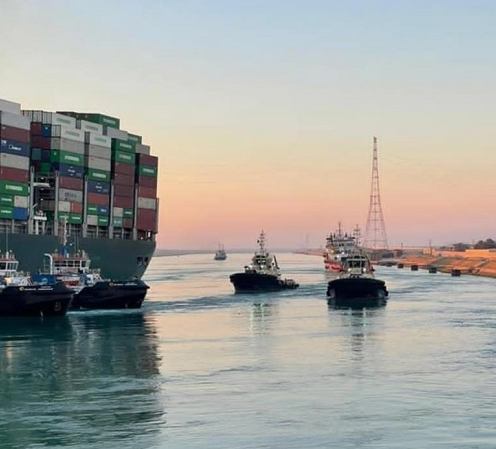The giant containership Ever Given, which ran aground in the Suez Canal last week, blocking passage on both sides of the waterway and creating a massive logjam, has finally been refloated.
To remind, the 20,000 TEU ship, flying the flag of Panama, has been taken on time-charter by Taiwanese shipping major Evergreen from Japan-based Shoei Kisen Kaisha.
The breakthrough is being reported across global media citing Inchcape Shipping, which shows Ever Given as dislodged and floating on the satellite map. Efforts are said to be underway to secure the vessel.
Offshore Energy Green Marine has reached out to Evergreen Marine for a confirmation and is yet to receive an official statement on the matter.
Meanwhile, the Suez Canal Authority has issued a statement saying that Ever Given was successfully floated this morning as the ship ‘responded to towing maneuvers’, dislodging the ship from the sand bank.
As informed, the maneuvers are scheduled to resume again later today as the water level rises to its maximum height of 2 meters in the period from 11:30 a.m., allowing the ship’s course to be completely modified to the midway.
Lieutenant General Osama Rabie, Chairman of Suez Canal Authority, reassured the international maritime community that the navigation in the canal would be restored once the vessel is fully floated and directed to wait in the Lakes region for its technical examination.
He also praised the heroic men of the Suez Canal Authority who worked tirelessly around the clock to refloat the vessel and enable the canal to return to normalcy.
GAC Egypt also confirmed the reports informing that the work to refloat the grounded container vessel restarted at about 03:30 a.m. local time on Monday, March 29.
“By 0450 hours, about 15 tugs involved in the operation had managed to almost refloat the ship,” GAC added.
“The ship’s aft was completely freed, whilst the bow was nearly free, and tugs were continuing to push and pull to move the bow. Work was also still continuing to refloat the bow side of the vessel.”
The refloating of the grounded containership is being reported on the back of a massive salvage operation, which saw more than 20,000 tons of sand and mud removed from the grounding site to free the ship.
Shoei Kisen appointed two maritime professional rescue teams for the job: Smit Salvage, from the Netherlands, and Nippon Salvage from Japan.
Around 10 tugboats and two dredger vessels were deployed to the scene, with additional machinery and equipment on the banks assisting the effort.
The dredging operation has succeeded in loosening Ever Given’s bow within the bank of the Suez Canal and the ship’s stern has been cleared from the sand bank, Evergreen said on Sunday.
“The rudder and propeller of the vessel are fully functional and expected to provide additional support to tugboats assigned to move the container ship from the accident site so that normal transit may again resume within the canal,” the company explained over the weekend.
Impact of the 6-day blockage
The grounding resulted in the blockage of one of the most important trade arteries of the world, which accounts for 12% of the global trade. Estimates from Bloomberg indicate that the gridlock has halted $9.6 billion worth of traffic a day.
Figures show that over 300 ships were waiting at anchorage over the weekend to pass through the canal, with the container shipping sector believed to have been impacted the most.
“Currently, Maersk and partners have three vessels stuck in the canal and 27 vessels waiting to enter the canal, with two more expected to reach the blockage today. We have until now redirected 15 vessels around the Cape of Good Hope at the southern tip of Africa,” Maersk said in a customer advisory on Sunday.
Redirecting vessels also means that these vessels will be missing somewhere else during that time, leading to further shortage in the market.
“For the immediate term we also anticipate higher short-term (or spot) rates, with vessels being delayed this week and missing in the system. However long-term it will not continue as volumes will go down. At the current time we do not expect this to change the overall prospects for the year towards a normalisation,” Maersk explained.
Its 2M partner MSC shared similar concerns saying all of major container carriers’ services had been affected by the incident.
“MSC expects this incident to have a very significant impact on the movement of containerized goods, disrupting supply chains beyond the existing challenges posed by the COVID-19 pandemic,” MSC added.
Therefore, a wave of container ships is expected to Europe’s hub ports in quick succession, stressing port facilities and inland infrastructure, and creating congestion in the ports.
Tanker market not affected significantly
According to the International Energy Agency (IEA), the blockage hasn’t caused a significant disruption in oil markets.
“While the inventory overhang that built up last year is gradually being worked off, crude and oil product stocks globally remain at comfortable levels. And some of the world’s largest and newest tankers are anyway too big to use the canal,” Kristin Petrosyan, IEA’s oil analyst said.
Oil prices have shown some volatility driven by the closure this week, Gibson said in a report, but fundamentally the oil market is well supplied, and demand continues to suffer from Covid-19 related disruptions.
Gibson projects that the biggest impact on the tanker market will be felt in terms of vessel supply/resupply and how trading patterns are disrupted.
“Delays coming through the canal simply mean that it will take longer for these vessels to come open for business once again. Those vessels which had already fixed but not loaded are now likely to miss their laycans, meaning charterers will have to seek replacement tonnage,” the market report reads.
Signal Group’s analysis of tanker types normally transiting the Suez shows that the most impacted are the Suezmaxes, Aframaxes and LR2 vessels. These vessel types trade through the Suez in both directions.
There were around 30 tankers above 25,000 dwt waiting to cross the Suez Canal as of March 26, the group’s data shows.
Most large crude tankers (VLCCs) have historically taken the route around the Cape when undertaking long East to West or West to East voyages.
As the gridlock in the waterway is cleared, the impact on the tanker market is expected to be reduced to a short-term effect for a few charterers and owners that are trying to carry cargo through the Canal.
“Mid-sized tankers (Suezmax, Aframax) are more likely to be affected, maybe more so on the carriage of refined products. Low levels of crude oil demand due to the third wave of coronavirus across Europe and the USA are keeping oil prices in check, yet we still saw a 4% rise in prices on a Friday,” Signal pointed out.
Credit; World Maritime News



























































